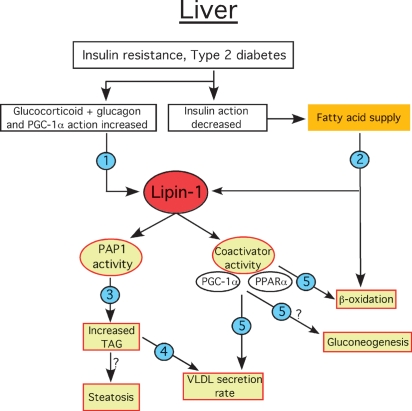Fig. 4.
Proposed physiological regulation and role of lipin-1 in hepatic lipid metabolism and insulin resistance. Under conditions of insulin resistance, increased action of glucocorticoids relative to insulin stimulates Lpin1 transcription and increases lipin-1 protein levels and PAP1 activity (1). Lack of suppression of adipose tissue lipolysis by insulin increases the fatty acid supply to the liver, which provides substrate for TAG synthesis and β-oxidation. Fatty acids also activate lipin-1 PAP1 activity by promoting its translocation to the ER membrane (2). Translocation of lipin-1 to the ER stimulates TAG synthesis and accumulation, which could potentially lead to steatosis (3). Increased TAG synthesis also influences the rate of VLDL secretion (4). Lipin-1 coactivator activity in conjunction with PGC-1α and PPARα increases transcription of genes involved in fatty acid oxidation and modulates rate of VLDL synthesis and secretion. It may also influence gluconeogenesis (5). The model is based on literature described in the text.

